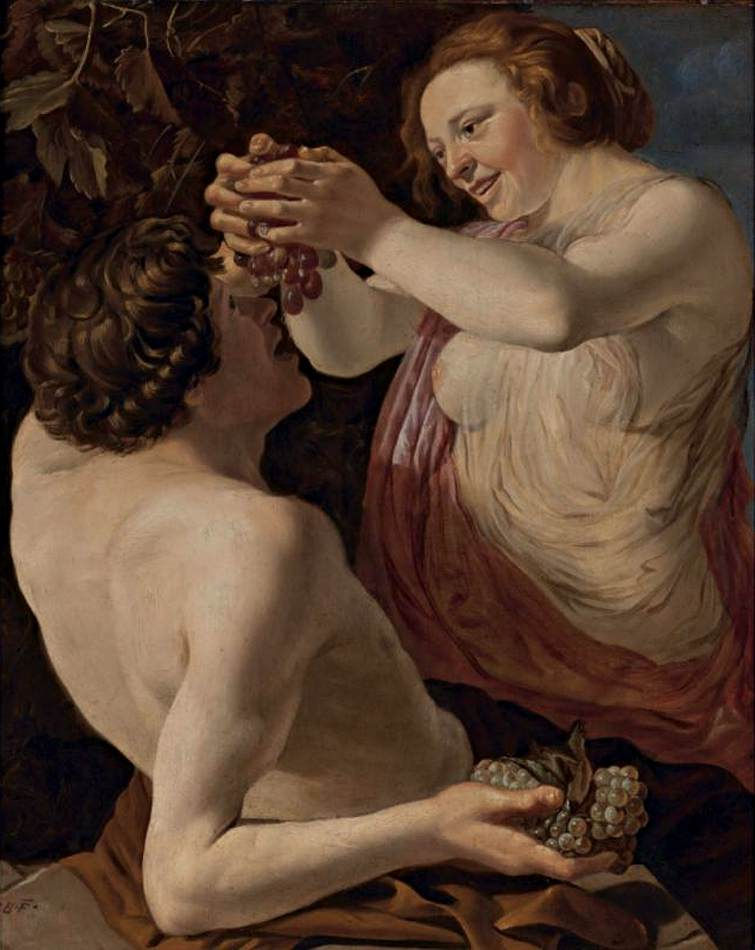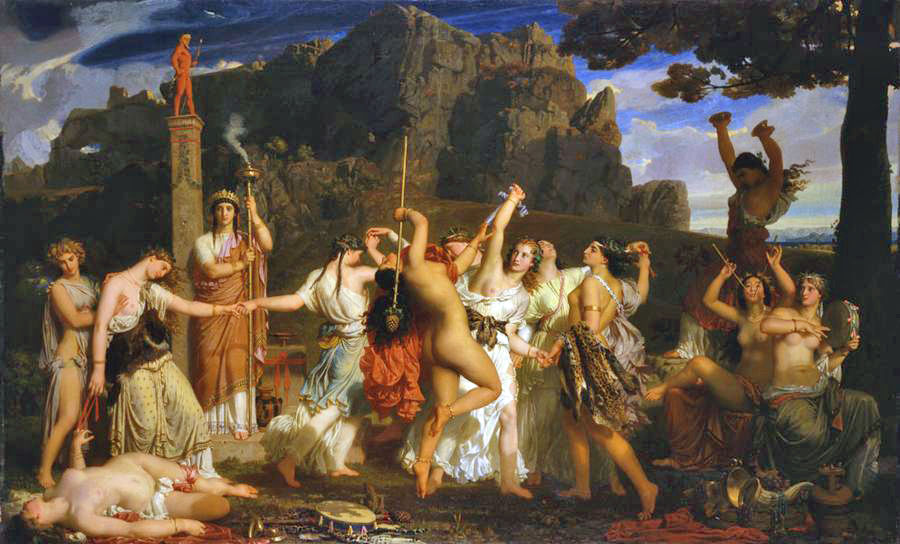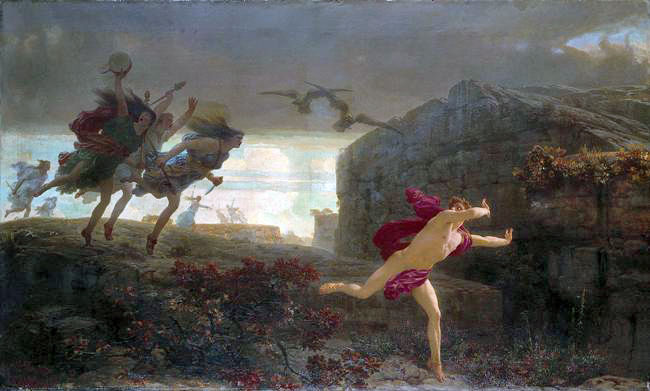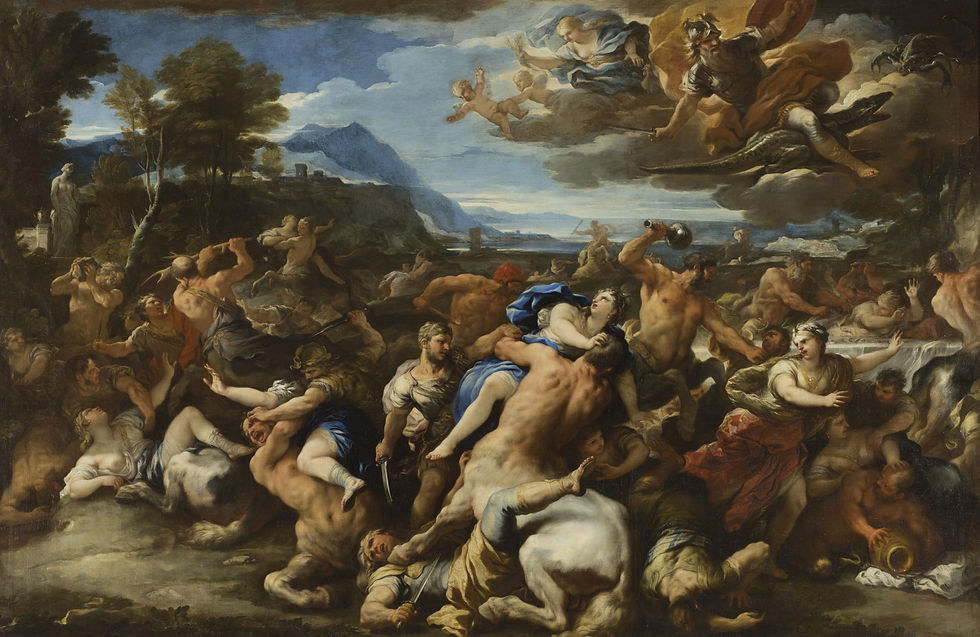Dionysus and his companions: a triumphant procession

TRIUMPHAL PROCESSION OF BACCHUS
Maerten van Heemskerck (1498-1574)
ca. 1536-1537
Kunsthistorisches Museum, Vienna
Pursued by his wife, Zeus takes Dionysus far from Greece, to the land of Nisa. He leaves him to be raised by nymphs. As an adult, Dionysus discovers vines, but is found and driven mad by Hera. He wanders through Egypt, Syria and Asia before reaching Phrygia, where the goddess Cymbeline welcomes, teaches and heals him. Upon Dionysus’s arrival in Thrace, the reigning king Lycurgus tries to take him prisoner.
Dionysus is protected by Thetis (a Nereid, or sea nymph) who offers to shelter him in the sea. Lycurgus, meanwhile, captures the Bacchantes in Dionysus’ entourage; they too manage to escape and the king is stricken with madness. Delusional, he cuts off his own leg and attacks his son with an axe, believing him to be Dionysus’s sacred vine. When Lycurgus comes to his senses, he realises what he has done; his land has also become infertile. An Oracle reveals that only his own death will calm the god’s wrath against him. He is attached to four horses and torn apart when they are sent galloping in different directions. Dionysus then leaves Thrace in order to go to India. He claims the territory after a magical armed conquest. This episode is at the origin of the triumphant procession, the god’s chariot pulled by panthers and decorated with vine branches and holly, which is accompanied by Silenus and other satyrs, centaurs and Maenads.
“And thou dost guide thy lynxes, double-yoked, with showy harness.—Satyrs follow thee; and Bacchanals, and old Silenus, drunk, unsteady on his staff; jolting so rough on his small back-bent ass; and all the way resounds a youthful clamor; and the screams of women! and the noise of tambourines! And the hollow cymbals! and the boxwood flutes…” (Ovid, Metamorphoses, IV, 24-30)
SILENUS: SATYR, ADOPTIVE FATHER AND GUARDIAN OF DIONYSUS

THE MISFORTUNES OF SILENUS Piero di Cosimo ca. 1500 - Fogg Art Museum, Harvard, Cambridge, MA, United States / 1

DRUNKEN SILENUS Jusepe di Ribera, 1626 - Museo di Capodimonte, Naples, Italy / 2

THE DRUNKEN SILENUS Pierre Paul Rubens, 1616-1617 - Alte Pinakothek, Munich, Germany
While Silenus never leaves Dionysus’ side (he is his adoptive father and guardian), he remains the personification of Drunkenness, not dissimilar in this sense from two other minor gods in Dionysus’ entourage, borne of Hybris (“Excess”) at the order of Hera: Comos (emblematic of “good cheer”) and Coros (“Satiety”). From the Renaissance onwards, Silenus often appears in art. He is traditionally portrayed as a fat old man, both ugly and lubricious, his drunkenness making him grotesque. Silenus is also “a generic term for old satyrs” (Pierre Grimal, Dictionnaire de la mythologie grecque et romaine).
1. In the centre, Silenus attempts to gather honey from a hollow tree without descending from his mount, a donkey. He is then attacked by bees. To the right, he is slowly put back on his feet.
2. Silenus, a satyr resembling an obese human, lies on the ground, his back slightly raised. His head is supported by the hands of his father, the god Pan.
SATYRS

NYMPH AND SATYR Christiaen van Couwenbergh, 1626-1628 - Private collection / 1

TWO SATYRS Pieter Pauwel Rubens, 1618-1619 - Alte Pinakothek, Munich, Germany

SATYR DRINKING FROM GRAPES David de Haen, beginning of the 17th century - Private collection
Satyrs are ambivalent creatures – half-man, half-goat – who live in the wild. Along with with the Maenads, they form Dionysus’ cortege, accompanying the god. They can also be associated with the god Pan. Satyrs mix freely with nymphs, minor divinities characterized by their youth and beauty, native to many places: forests and woods, fertile valleys, springs and rivers, mountains and caves, etc. As with Dionysus’ cortege, the nymphs often take part in divine processions.
1. It is assumed that the painting is an allegory of Taste, and it belonged to a series representing the five senses.
MAENADS: ANTIQUE BACCHANTES

THE DANCE OF THE BACCHANTES Charles-Gabriel Gleyre 1849 - Musée Cantonal des Beaux-arts, Lausanne, Switzerland

PENTHEUS, HUNTED BY THE MAENADS Charles-Gabriel Gleyre, 1864 - Kunstmuseum, Basel, Switzerland

DEATH OF ORPHEUS (LA MORT D’ORPHÉE) Émile Lévy, 1866 - Musée d’Orsay, Paris
The Maenads are the followers of Dionysus and accompany him on his travels, notably his voyage to India. They are not priestesses but play an important role in religion and worship. They participate in the mysteries and festivals held in honour of the god. Bare-chested, they wear lion skins and carry thyrsus staffs (ivy-wrapped spears). Personifying the orgiastic spirits of nature, they dance frenetically, plunging themselves into mystic ecstasy. Certain heroes were to fall victim to their prodigious strength. The Bacchantes (the Roman name for the Maenads) were said to behave like ferocious beasts.
CENTAURS

THE FIGHT BETWEEN THE LAPITHS AND THE CENTAURS Piero di Cosimo, prob. 1500-1515 - The National Gallery, London / 1

THE BATTLE OF CENTAURS AND LAPITHS AT HIPPODOMIA'S WEDDING Karel Dujardin, 1667 - Schloss Sanssouci, Potsdam, Germany / 2

BATTLE BETWEEN THE LAPITHS AND THE CENTAURS Lucas Giordano Late 1680s - The State Hermitage Museum, St. Petersburg, Russia / 3
Centaurs are sometimes presented as half-man, half-horse. Symbolizing animal appetites (for the Greeks, sensuality and drunkenness), they too make up part of Dionysus’ cortege. Their fight against the Lapiths can also be read as a parable of the struggle between nature and civilisation.
1 to 3. Pirithous married Hippodamia and invited the gods of Mount Olympus to the wedding. As the palace was not big enough for all the guests, his cousins the centaurs, as well as Nestor, Caeneus and other Thessalonian princes were housed in a nearby cavern, which was cool and dark. But the centaurs were unused to wine and, smelling it, they pushed away the curds that had been served to them and galloped to fill their silver horns with wine…
In their ignorance, they drank the wine undiluted and became so drunk that, when the bride arrived with her followers to greet them, Eurytion leapt from his seat, knocking over the table and, grabbing Hippodamia by her hair and dragging her away. The other centaurs followed his example, throwing themselves on the young men and women and trying to rape them. Pirithous and Theseus rushed to save Hippodamia, cutting off Eurytion’s nose and ears and, with the help of the Lapiths, throwing him out of the cavern. The ensuing battle, during which the Lapith Caeneus was killed, lasted until nightfall. Thus began the long war between the centaurs and their Lapith neighbours, both sides wishing to avenge the affronts of that day.
LOOKS CAN BE DECEIVING
.jpg)
BACCHANTE, André Lhote, 1912
Fine Arts Museum, Bordeaux
The mythological figure of the Bacchante experienced a resurgence in the art of the 19th and early 20th century. At first, it was the characters of Bacchus’ procession (the thiasus) who caught the artists’ attention. The Bacchant (or Maenad), priestess of Bacchus (or Dionysus) had some specific attributes: an animal skin, usually panther; a cup of wine, a crown of ivy or vine branches, and a thyrsus. The 19th-century bacchante, at the service of the god of wine, is a creature of the flesh. She follows her desires and demonstrates a wild sensuality – thereby offering artists the possibility of depicting an ecstatic, equivocal or even licentious nudity. Painters and sculptors began to use the myth more and more as a pretext for showing the eroticism of rearing, arching bodies. The bacchante loses her mythological attributes to become a nude woman, free from all constraints. The notion of drunkenness and sensuality remains. (Source: La Tribune de l’art).
André Lhote’s Bacchante is a fleshy, naked women with generous curves. In a lascivious pose, showing her state of abandon, she eats grapes in praise of Bacchus in a bucolic setting. She is celebrating life’s pleasures. Rodin took a similar approach with his erotic drawings of nude models, which he exhibited without embarrassment; he only gave them the title Bacchante some time later. This was probably the case for Lhote too. This title allowed the artists to ward of attacks from various leagues of virtue, which were numerous at the time.
The title therefore leads to confusion: this modern bacchante is far removed from the bacchante of Antiquity, even if her grapes do indicate the presence of wine.
GALLERIES NECTAR OF THE GODS
Wine and Painting > From Divine to Sacred > Nectar of the Gods > Followers of Dionysus




